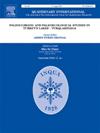Source-to-sink process of sediments in the central muddy area of the south Yellow Sea since the middle MIS 3
IF 1.8
3区 地球科学
Q3 GEOGRAPHY, PHYSICAL
引用次数: 0
Abstract
Identifying sediment sources in the continental shelf muddy area provides a critical foundation for elucidating source-to-sink processes. This study investigates the sediment provenance of core YS01 from the western Central Yellow Sea Mud (CYSM) to reconstruct the source-to-sink processes in the South Yellow Sea (SYS) since the middle MIS 3. Clay mineral assemblages and Sr-Nd isotope compositions reveal that the Yellow River and Yangtze River are the dominant sediment sources in the study area since the middle marine isotope stages (MIS) 3. Mixed detrital sediments from these two rivers were identified in the strata deposited during the 8.3–0.3 ka (mid-late MIS 1) and 42.6–31.4 ka (mid-late MIS 3), closely linked to nearshore seafloor erosion driven by the East Asian Winter Monsoon (EAWM). The key distinction between these two periods lies in the weakened intensity of the East Asian Summer Monsoon (EASM) intensity during the mid-late MIS1, which significantly reduced the contribution of Yangtze River-derived suspended sediments to the study area in summer. In contrast, during the 12.0–10.9 ka (early MIS 1), the suspended sediment from the Yangtze River in summer became the dominant sediment source, transported to the study area by the northward-flowing Yellow Sea Coastal Current (YSCC) and the Changjiang Diluted Water (CDW), both influenced by the intensified EASM. In general, source-to-sink processes in the SYS since the middle MIS 3 are predominantly controlled by the East Asian Monsoon.
3期中期以来南黄海中部泥质区沉积物源-汇过程
确定陆架混浊区沉积物源为阐明源-汇过程提供了重要的基础。本文通过对中黄海泥(CYSM)西部YS01岩心沉积物物源的研究,重建了中黄海3期中期以来南黄海的源汇过程。黏土矿物组合和Sr-Nd同位素组成表明,自中期海相同位素阶段(MIS) 3以来,黄河和长江是研究区主要的沉积物来源。在8.3 ~ 0.3 ka (MIS 1中后期)和42.6 ~ 31.4 ka (MIS 3中后期)沉积的地层中发现了这两条河流的混合碎屑沉积物,与东亚冬季风(EAWM)驱动的近岸海底侵蚀密切相关。这两个时期的主要区别在于MIS1中后期东亚夏季风(EASM)强度减弱,显著降低了夏季长江悬浮沉积物对研究区的贡献。而在12.0 ~ 10.9 ka (MIS 1早期),夏季扬子江的悬沙成为主要的沙源,并由黄海沿岸流(YSCC)和长江稀释水(CDW)向研究区输送,两者都受到EASM增强的影响。总体而言,自MIS 3中期以来,南亚的源-汇过程主要受东亚季风控制。
本文章由计算机程序翻译,如有差异,请以英文原文为准。
求助全文
约1分钟内获得全文
求助全文
来源期刊

Quaternary International
地学-地球科学综合
CiteScore
5.60
自引率
4.50%
发文量
336
审稿时长
3 months
期刊介绍:
Quaternary International is the official journal of the International Union for Quaternary Research. The objectives are to publish a high quality scientific journal under the auspices of the premier Quaternary association that reflects the interdisciplinary nature of INQUA and records recent advances in Quaternary science that appeal to a wide audience.
This series will encompass all the full spectrum of the physical and natural sciences that are commonly employed in solving Quaternary problems. The policy is to publish peer refereed collected research papers from symposia, workshops and meetings sponsored by INQUA. In addition, other organizations may request publication of their collected works pertaining to the Quaternary.
 求助内容:
求助内容: 应助结果提醒方式:
应助结果提醒方式:


